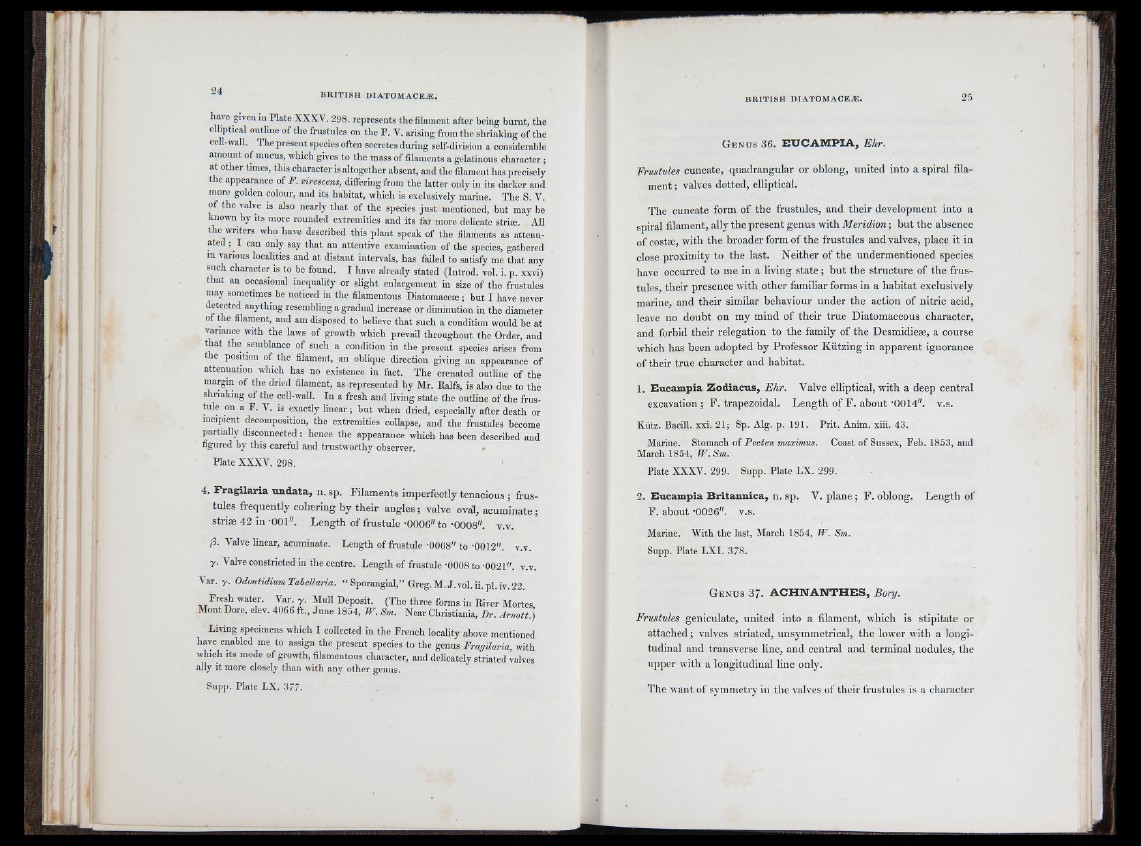
have given in Plate XXXV. 298. represents the filament after being burnt, the
elliptical outline of the frustules on the P. V. arising from the shrinking of the
cell-wall. The present species often secretes during self-divisioii a considerable
amount of mucus, wliicli gives to the mass of filaments a gelatinous character ;
at other times, this character is altogether absent, and the filament has precisely
the appearance of F. virescens, differing from the latter only in its darker and
more golden colour, and its habitat, which is exclusively marine. The S. V.
of tbe valve is also nearly that of the species just mentioned, but may be
known by its more rounded extremities and its far more delicate striæ. All
the writers who have described this plant speak of the filaments as attenuated
; I can only say that an attentive examination of the species, gathered
m various localities and at distant intervals, has failed to satisfy me that any
such character is to be found. I have already stated (Introd. vol. i. p. xxvi)
that an occasional inequality or slight enlargement in size of the frustules
may sometimes be noticed in the filamentous Diatomaceæ ; but I have never
detected anything resembling a gradual increase or diminution in the diameter
of the filament, and am disposed to believe that such a condition would be at
variance with the laws of growth which prevail throughout the Order, and
that the semblance of such a condition in the present species arises from
the posrtion of the filament, an oblique direction giving an appearance of
attenuation which has no existence in fact. The crenated outline of the
margin of the dried filament, as represented by Mr. Balfs, is also due to the
shrinking of the cell-wall. In a fresh and living state the outline of the frustule
on a F. V. is exactly Uuear; but when dried, especially after death or
incipient decomposition, the extremities collapse, and the frustules become
partially disconnected ; hence the appearance which has been described and
figured by this careful and trustworthy observer.
Plate XXXV. 298,
4. Fragilaria undata, n. sp. Filaments imperfectly tenacious ; frustules
frequently cohering by their angles; valve oval, acuminate ;
striae 42 in -OOl". Length of frustule -0006" to -0008". v.v.
13. Valve linear, acuminate. Length offrustule -0008" to -0012". v.v.
y. Valve constricted in the centre. Length of frustule-0008 to -0021". v.v.
Var. y. Odontidium Tabellaria. “ Sporangial,” Greg. M.J.vol. ii. pi. iv. 22.
Freffi water. Var y. Mull Deposit. (The three forms in River Mortes,
Mont Dore, elev. 4066 ft., June 1854, W. Sm. Near Christiania, Dr. Arnott.)
Living specimens which I collected in the French locality above mentioned
have enabled me to assign the present species to the genus Fragilaria, with
which Its mode of growth, filamentous character, and delicately striated valves
ally It more closely than with any other genus.
Supp. Plate LX. .377.
Genus 36. EXJCAMPIA, Fhr.
Frustules cuneate, quadrangular or oblong, united into a spiral filament
; valves dotted, elliptical.
The cuneate form of the frustules, and their development into a
spiral filament, ally the present genus with Meridion ; but the absence
of costæ, with the broader form of the frustules and valves, place it in
close proximity to the last. Neither of the undermentioned species
have occurred to me in a living state ; but the structure of the frustules,
their presence with other familiar forms in a habitat exclusively
marine, and their similar behaviour under the action of nitric acid,
leave no doubt on my mind of their true Diatomaceous character,
and forbid their relegation to the family of the Desmidieæ, a course
which has been adopted by Professor Kützing in apparent ignorance
of their true character and habitat.
1. Eucampia Zodiacus, Ehr. Valve elliptical, with a deep central
excavation ; F. trapezoidal. Length of F. about -0014". v.s.
Kütz. Bacill. xxi. 21; Sp. Alg. p. 191. Prit. Anim. xiii. 43.
Marine. Stomach of Pecten maximus. Coast of Sussex, Feb. 1853, and
March 1854, W.Sm.
Plate XXXV. 299. Supp. Plate LX. 299.
2. Eucampia Britannica, n. sp. V. plane ; F. oblong. Length of
F. about -0026''. v.s.
Marine. "With the last, March 1854, W. Sm.
Supp. Plate LXI. 378.
G e n u s 37- A C H N A N T H E S , Bory.
Frustules geniculate, united into a filament, which is stipitate or
attached; valves striated, unsymmetrical, the lower with a longitudinal
and transverse line, and central and terminal nodules, the
upper with a longitudinal line only.
The want of svmmetrv in tlie valves of their frustules is a cliaracter